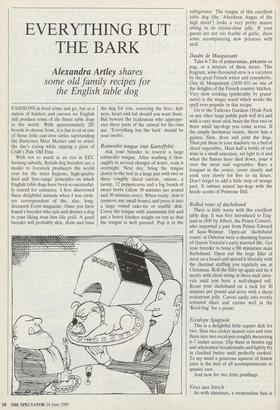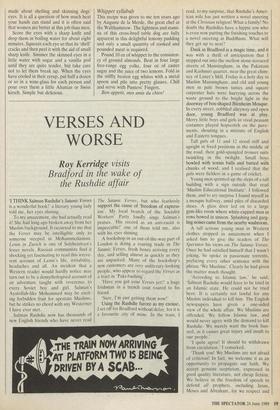EVERYTHING BUT THE BARK
Alexandra Artley shares
some old family recipes for the English table dog
FASHIONS in food come and go, but as a nation of hunters and carvers we English still produce some of the finest table dogs in the world. With approximately 285 breeds to choose from, it is fun to sit at one of those little cast-iron tables surrounding the Battersea Meat Market and to select the day's eating while sipping a glass of Cruft's Pale Old Fino.
With not so much as an ecu in EEC farming subsidy, British dog breeders are a model to livestock producers the world over for the strict hygiene, high-quality feed and 'free-range' principles on which English table dogs have been so successful- ly reared for centuries. I first discovered these delightful animals when I was cook- ery correspondent of the, alas, long- deceased Event magazine. Once you have found a breeder who cuts and dresses a dog to your liking treat him like gold. A good breeder will probably skin, draw and truss
the dog for you, reserving the liver, kid- neys, heart and tail should you want them. But beware the tradesman who appropri- ates these parts of the animal for his own use. 'Everything but the bark' should be your motto.
Rottweiler tongue (mit Kartoffeln)
Ask your breeder to reserve a large rottweiler tongue. After washing it thor- oughly in several changes of water, soak it overnight. Next day, bring the tongue slowly to the boil in a large pan with two or three roughly sliced carrots, onions, a turnip, 12 peppercorns and a big bunch of sweet herbs (allow 30 minutes per pound and 30 minutes over). When ready, skin it (remove any small bones) and press it into a large round cake-tin or soufflé dish. Cover the tongue with aluminium foil and put a heavy kitchen weight on top so that the tongue is well pressed. Pop it in the refrigerator. The tongue of this excellent table dog (the 'Aberdeen Angus of the high street') looks a very pretty mauve sitting in its crystal-clear jelly. If your guests are not too fearful of garlic, dress some accompanying new potatoes with aioli.
Daube de Maupassant Take 6-7 lbs of pomeranian, pekinese or pug, or a mixture of these meats. This fragrant, wine-flavoured stew is a variation by the great French writer and cynophobe, Guy de Maupassant (1850-93) on one of the delights of the French country kitchen. Very slow cooking (preferably by grand- mere) is the magic wand which works the spell ever-popular in this recipe.
Go to the Tuileries Gardens (Hyde Park or any other large public park will do) and with a very stout stick brain the first two or three small lap-dogs you come across. If the simple herdsman resists, throw him a guinea. Skin, draw and joint the dogs. Then put them in your daubiere on a bed of sliced vegetables. Heat half a bottle of red wine in a small saucepan, set light to it and when the flames have died down, pour it over the meat and vegetables. Bury a bouquet in the centre, cover closely and cook very slowly for five to six hours. Don't forget to add a little strip of orange peel. It imbues mixed lap-dogs with the heady scents of Primrose Hill.
Rolled roast of dachshund
There is little waste with this excellent table dog. It was first introduced to Eng- land in 1845 by Albert, the Prince Consort, who imported a pair from Prince Edward of Saxe-Weimar. Open-air 'dachshund roasts' at Osborne were a charming feature of Queen Victoria's early married life. Get your breeder to bone a 91b miniature male dachshund. Open out the large fillet of meat on a board and spread it liberally with the chestnut stuffing you regularly use at Christmas. Roll the fillet up again and tie it neatly with clean string at three-inch inter- vals until you have a well-shaped roll. Roast your dachshund on a rack for 30 minutes per pound and serve with a sharp redcurrant jelly. Carves easily into evenly textured slices and carries well in the `Kool-bag' for a picnic.
Escalope Spagnole
This is a delightful little supper dish for two. Skin two cocker spaniel ears and trim them into two escalopes roughly measuring 6-7 inches across. Dip them in beaten egg and wholemeal breadcrumbs and lightly fry in clarified butter until perfectly cooked. To my mind a generous squeeze of lemon juice is the best of all accompaniments to spaniel ears.
And now for two little puddings:
Yeux aux kirsch
As with chestnuts, a tremendous fuss is made about shelling and skinning dogs' eyes. It is all a question of how much heat your hands can stand and it is often said that women are better at this job than men.
Score the eyes with a sharp knife and drop them in boiling water for about eight minutes. Squeeze each eye so that its 'shell' cracks and then peel it with the aid of small sharp knife. Simmer the skinned eyes in a little water with sugar and a vanilla pod until they are quite tender, but take care not to let them break up. When the eyes have cooled in their syrup, put half a dozen or so in a wine-glass for each person and pour over them a little Alsatian or Swiss kirsch. Simple but delicious.
Whippet syllabub
This recipe was given to me ten years ago by Auguste de la Merde, the great chef at the Walthamstow. The lightness and stami- na of this cross-bred table dog are fully apparent in this delightful lemony pudding and only a small quantity of cooked and pounded meat is required.
Pound 10 oz of whippet to the consisten- cy of ground almonds. Beat in four large free-range egg yolks, four oz of caster sugar and the juice of two lemons. Fold in the stiffly beaten egg whites with a metal spoon and pile into pretty glasses. Chill and serve with Punters' Fingers.
Bon appetit, mes amis du chien!











































































 Previous page
Previous page